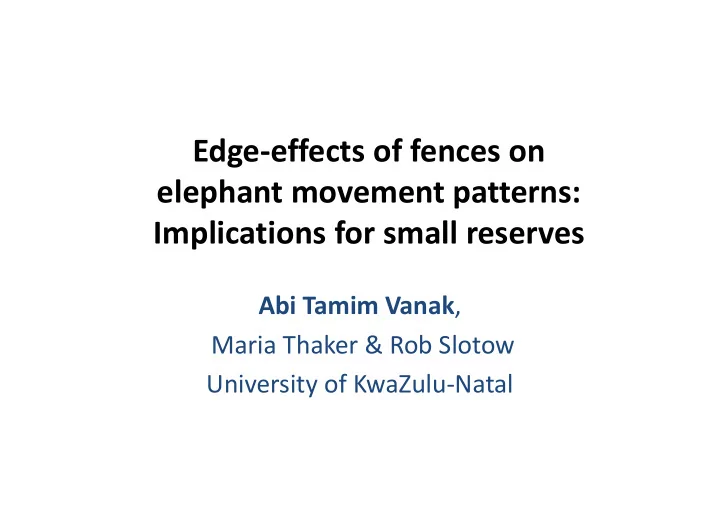

Edge-effects of fences on elephant movement patterns: Implications for small reserves Abi Tamim Vanak , Maria Thaker & Rob Slotow University of KwaZulu-Natal
Humans, fences and wildlife Keep wildlife out
Keep wildlife in
Effects of fences • Positive – Reduce human-wildlife conflict – Manage wildlife/livestock populations – Highway fencing - reduce collisions – Prevent spread of diseases
Effects of fences • Negative – Constrain movement – Prevent dispersal – Cut migration routes – Physical contact – entanglement, electrocution
Effects of fences • Population level responses • Behavioural responses? – Linear feature -> Habitat edge – Edge-effects on behaviour – Extent of edge-effects
Elephant as ecosystem engineers • Megaherbivore – Ecosystem engineers • Elephant movement behaviour affects many ecological processes
Elephants and vegetation • Concern over deleterious effects of elephants on vegetation • Large trees – Foliage utilization – Breaking of large branches – Debarking – Pushing over
Fences and elephants • In free-ranging populations – Cut migratory routes – Restrict seasonal movement • Revisit areas near the fence – Over-utilisation close to fences
Fences and elephants • Most South African reserves are fenced • Reintroduced populations – soft release • Aversive conditioning to electric fence
Elephants and fences • Close proximity to the fence will affect elephant movement – 1) Elephant will “bunch-up” near the fence • Over-utilisation of resources near the fence – 2) If elephant show aversive behaviour then avoidance of fence • Or movement rates near fence will be faster • Greater net-daily displacement
Elephants in Pilanesberg NP • Six GPS collared females – Represents six herds • Data collected 4-6 hourly – from 2004-2007 • Based on the autocorrelation function, sampling interval gap of 24 h yielded spatially independent movement paths (ACF = 0.019, Q = 0.277, P = 0.6)
Elephant movement paths • Movement rates • Daily net displacement – In relation to fence • 3806 daily paths – Subsampled to >24hour – 1113 dry season paths – 790 wet season paths
Model fitting 5 Dry season Wet season Daily net displacement (km) � Daily net displacement (km) 4 4 � � � � � 3 � 3 � � � � � � � � � � � � � � � � � � � � � � � � 2 � 2 � � � � � � T T 1 1 1 2 3 4 5 6 7 8 9 10 10 1 2 3 4 5 6 7 8 9 Minimum distance from fence (km) Minimum distance from fence (km)
Model fitting Dry season AIC ΔAIC w Piecewise regression 19280.32 0 0.971 Sigmoidal function 19287.32 7 0.029 Linear regression 19364.9 84.58 0.000 Wet season Piecewise regression 13849.51 0 0.986 Sigmoidal function 13858.01 8.48 0.014 Linear regression 13882.76 33.25 0.000
Edge-effects of fences Piece-wise regression analysis (β = - 0.47) (β = - 0.75) (β = - 0.01) (β = 0.04) Vanak, Thaker and Slotow 2010 Biol. Cons. 143: 2631-2637
Fences and Elephant movement • Daily net-displacement was higher near fence in both seasons • Effect dissipates at 2.6 km in dry season & 3.8 km in wet season • Fence effects over-ride seasonal effects – Lower net displacement in dry compared wet season
Edge-effects of fences Piece-wise regression analysis (β = - 0.47) (β = - 0.75) (β = - 0.01) (β = 0.04) Vanak, Thaker and Slotow 2010 Biol. Cons. 143: 2631-2637
Dynamic vs. Static analyses On either side of the spatial breakpoint in movement behaviour: • No difference in proportion of locations • No difference in habitat composition (wet season: χ 2 = 9.15, p = 0.10; dry season: χ 2 = 7.64, p = 0.18) • Few differences in habitat selection – Grassland: selected in the centre, avoided near the fence – Acacia mellifera : avoided in the centre, selected near the fence By using movement metrics – Discriminate non-linear behavioural responses – Spatially explicit fence effects
Cascading edge-effect of fences • “Streaking” behaviour • Lower tortuosity near fences – Lowered foraging – Transfer of foraging pressure to center of reserve • Elephant transmit edge-effect of fences to rest of reserve
Cascading edge-effect of fences • Reserve shape - High edge-to-area ratio exacerbates edge-effect of fences - Carrying capacity of reserves is smaller 500 m = 10% of under- utilized space Solution? Pongola Game Reserve - Drop fences to optimize reserve size and shape
Acknowledgements • Amarula Elephant Research Programme • University of KwaZulu-Natal Research Office • PPC Cement South Africa • National Research Foundation • Northwest Parks and Tourism Board
Recommend
More recommend